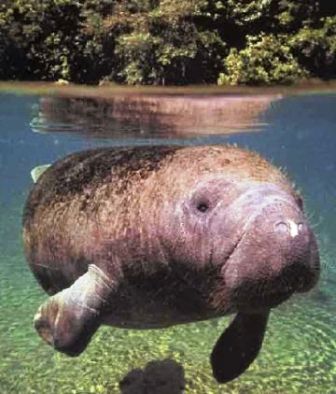Discover Florida Nature
It's time to explore the natural Florida


|
|
|
|
|
 The
Florida manatee is a native species found in all parts of the State.
Protections for Florida manatees were first enacted in 1893. Today,
they are protected by the Florida Manatee Sanctuary Act, Florida
Statutes and are federally protected by both the Marine Mammal
Protection Act and the Endangered Species Act. The
Florida manatee is a native species found in all parts of the State.
Protections for Florida manatees were first enacted in 1893. Today,
they are protected by the Florida Manatee Sanctuary Act, Florida
Statutes and are federally protected by both the Marine Mammal
Protection Act and the Endangered Species Act.West Indian manatees are large, aquatic mammals with a body that tapers to a flat, paddle-shaped tail. They are grayish-brown in color and have two flippers with nails on them. The head and face of these animals are wrinkled with whiskers on the snout. The closest relative to the West Indian manatee is the elephant! The average, adult manatee is about 10 feet long and weighs about 1,000 pounds. They can reach up to 13 feet in length and weigh up to 3,000 pounds. Manatees have no "biting" teeth, only "grinding" teeth. A manatee's teeth (all molars) are constantly being replaced. New teeth come in at the back of the jaw and move forward about a centimeter a month. The front molars eventually fall out and are replaced by the teeth behind them. This tooth replacement is an adaptation to the manatee's diet, as it consumes plants that may hold a lot of sand. Manatees are concentrated in Florida in the winter, but can be found as far west as Louisiana and as far north as Virginia and the Carolinas in the summer months. The Manatee lives in warm, shallow rivers, bays, estuaries and coastal waters and seldom live in waters that are below 68 degrees Fahrenheit. The manatee prefers water that has a depth of 1-2 Meters, and the clarity of the water is not important. Near the coast the water is about 3-5 meters deep and that is where manatees usually travel, avoiding currents that are in excess of 5 kilometers. Manatees are a migrant species. People from around the world have come to Crystal River to see the manatees. Citrus County is currently the only place in the US where you can interact and swim with the West Indian manatee without that act being viewed as harassment by Law Enforcement. This endangered species makes Citrus County's spring fed rivers its wintering home. Manatees are very gentle, slow-moving, graceful swimmers. A manatee uses its flippers and tail to steer itself through the water and moves its tail up and down to propel itself forward. Manatees are quite agile in the water. They can swim upside down, roll, do somersaults or move vertically in the water. Manatees emit sound under the water. They make these sounds when they are freighted, or interacting with another. Sound is not the only form of communication that a manatee will use there are sight, taste, touch, and smell.  Manatees
are herbivores, which means they eat plants. Also known as a "sea cow,"
manatees usually spend up to eight hours a day grazing on seagrasses and
other aquatic plants. A manatee can consume up to 10 percent of its body
weight in aquatic vegetation daily. The manatee uses its muscular lips
to tear plants much like an elephant uses its trunk. Manatees
are herbivores, which means they eat plants. Also known as a "sea cow,"
manatees usually spend up to eight hours a day grazing on seagrasses and
other aquatic plants. A manatee can consume up to 10 percent of its body
weight in aquatic vegetation daily. The manatee uses its muscular lips
to tear plants much like an elephant uses its trunk.Manatees are mammals. They must surface approximately every five minutes to breathe, but can hold their breath for as long as twenty minutes when resting. The manatee's nose is usually the only part of its body that comes out of the water when it breathes. If they are using a lot of energy, they may surface to breathe as often as every 30 seconds. Manatees rest from 2 to 12 hours a day either suspended near the water's surface or lying on the bottom, usually for several hours at a time. The reproductive rate for the manatee is very slow. Female manatees are not sexually mature till they are about five years old, and males not until nine years old. One calf is born every 2-5 years, birth of twins may occur but is not frequent. The gestation period is about 13 months. Manatees breed year round in Florida, however most of the calf's are born in the spring and summer months. At birth the calf measures about 4 to 41/2 feet and weighs about 60-70 pounds. A newborn calf can swim at the surface of the water by itself. The newborn is capable of vocalizing when they are born. Several hours after birth the calf begins to nurse from it's mother's teat. Calves nurse under water. A few weeks after being born the infant begins to nibble on plants. The calf may stay with the mother for up to two years before going out on it's own, it stays with the mother to learn survival, travel routes and warm water refuges. Manatees have no natural enemies, and it is believed they can live 60 years or more. Many manatee mortalities are human-related. Most occur from collisions with watercraft. The loss of habitat is the most serious threat facing the manatee today. There are approximately 2,600 West Indian manatees left in the United States. |
|
|
Advertise | Privacy Statement | Dog Encyclopedia | Video |Contact | Alaska Nature |
|